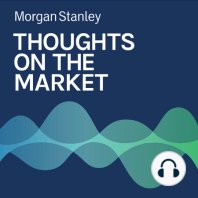3 min listen

Vishy Tirupattur: A Challenging Road for Commercial Real Estate
Vishy Tirupattur: A Challenging Road for Commercial Real Estate
ratings:
Length:
3 minutes
Released:
Mar 30, 2023
Format:
Podcast episode
Description
As regional banks contend with sector volatility, commercial real estate could face challenges in securing new loans and refinancing debt when it matures.----- Transcript -----Welcome to Thoughts on the Market. I am Vishy Tirupattur, Morgan Stanley's Chief Fixed Income Strategist. Along with my colleagues, bringing you a variety of perspectives, I'll be talking about some of the challenges facing the commercial real estate markets. It's Thursday, March 30th at 11 a.m. in New York. Commercial real estate market, or CRE in short, is a hot topic, especially in the context of recent developments in the banking sector. As we have discussed on this podcast, even though banks were already tightening lending standards, given recent events their ability and willingness to make loans is diminished. Besides making loans, banks enable credit formation as buyers of senior tranches of securitizations. A regulatory response to recent events will likely decrease the ability of regional banks to be buyers of such tranches, if risk rates and liquidity capital ratio requirements are revised to reflect duration in addition to credit risk. It's against this backdrop that we think about the exposure of regional banks to CRE. Understanding the nature of CRE financing and getting some numbers is useful to put this issue in context. First, commercial real estate mortgage financing is different from, say, residential real estate mortgage financing in that they are generally non-amortizing mortgages with terms usually 5 or 10 years. That means at term there is a balloon payment due which needs to be refinanced into another 5 or 10 year term loan. Second, there is a heightened degree of imminence to the refinancing issue for CRE. $450 billion of CRE debt matures this year and needs to be refinanced. It doesn't really get easier in the next few years, with CRE debt maturing and needing to be refinanced of about $550 billion per year until 2027. In all, between 2023 and 2027, $2.5 trillion of CRE debt is set to mature, about 40% of which was originated by the banking sector. Third, retail banks' exposure to CRE lending is substantial and their share of lending volumes has been growing in recent years. 70% of the core CRE debt in the banking sector was originated by regional banks. These loans are distributed across major CRE sub-sectors and majority of these loans are under $10 million loans. That the share of the digital banks in CRE debt has ramped up meaningfully in the last few years is actually very notable. That means the growth in their CRE lending has come during a period of peaking valuations. Even in sub-sectors such as multifamily, where lending has predominantly come from other sources, such as the GSEs, banks play a critical role in that they are the buyers of senior tranches of agency commercial mortgage backed securities. As I said earlier, if banks' ability to buy such securities decreases because of new regulations, this indirectly impacts the prospects for refinancing maturing debt in the sector as well. So what is the bottom line? Imminent refinancing needs of commercial real estate are a risk and the current banking sector turmoil adds to this challenge. We believe CRE needs to reprice and alternatives to refinance debt are very much needed. Thanks for listening. If you enjoy the show, please leave us a review on Apple Podcasts and share Thoughts on the Market with a friend or colleague today.
Released:
Mar 30, 2023
Format:
Podcast episode
Titles in the series (100)
Andrew Sheets: For Markets, Signs, Signs, Everywhere Signs by Thoughts on the Market